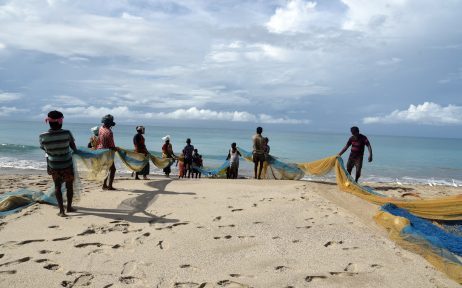By Sugato Mukherjee

Fisherfolk hauling in a net filled with fish after a boat returns on Dhanushkodi’s shores. They form human chains on both ends of a long rope, and pull the heavy net onto the sandy beach.Credit: Sugato Mukherjee
The marine life of Dhanushkodi is plentiful and it is home to exotic varieties of fish, crabs, and lobsters.Credit: Sugato Mukherjee
Fishing in Bay of Bengal and the Indian Ocean depends on seasonal winds and fishermen elsewhere in coastal areas of India operate for five or six months in a year. However, Dhanushkodi fishermen can take advantage of its unique location at the confluence of the two seas. They carry on fishing year-round, using their intense knowledge of the local marine life.Credit: Sugato Mukherjee
A fisherwoman carrying the day’s catch to sell.Credit: Sugato Mukherjee
For nearly half a century after that fateful night in December 1964, Dhanushkodi’s fishing hamlet has been deprived of most of the basic necessities. Once a week, the inhabitants get a supply of water from the municipality of Rameshwaram, which is Dhanushkodi’s link to the outside world.Credit: Sugato Mukherjee
There is only one middle school for the children in Dhanushkodi. Access to further studies is possible only at Rameshwaram, 20 kilometers away.Credit: Sugato Mukherjee
According to Indian mythology, Lord Rama, a Hindu god, marked this place with the end of his bow to build a bridge. This gave the place its name: Dhanushkodi, meaning “end of the bow.” This has lent a deep religious significance to Dhanushkodi, and it had been a prime spot of religious tourism before the cyclone destroyed the town in 1964.Credit: Sugato Mukherjee
In 2019, a 20-km tar road was built from Rameshwaram to Dhanushkodi, restoring the connectivity of this forgotten town with India’s mainland. This had resulted in a boost in religious tourism.Credit: Sugato Mukherjee
The better road connectivity led to an increase in daytrippers looking to soak in the charm of the raw, uncluttered beauty of the powdery-white beaches and Dhanushkodi’s photogenic ruins. Amid government plans to build tourism infrastructure, hope was alive after half a century.Credit: Sugato Mukherjee
Senthil, 21, is a young fisherman who has supplemented his earnings from fishing with his makeshift stall on the coast selling sea shells and handcrafted knick-knacks to tourists. But the pandemic-induced lockdown has been a double whammy for him, with fishing activities disrupted and a complete closure of tourism.Credit: Sugato Mukherjee
Saravadurai, 67, was barely in his teens when the cyclone of 1964 almost wiped off Dhanushkodi from the map. He remembers a happy childhood in the bustling, prosperous seaside town. He is displaying his fisherman’s identity card and says, in spite of all odds, he will not leave this coastal land. “Sea is our life,” he says simply.Credit: Sugato Mukherjee
Horse-drawn carriages were used to carry the catch of the day to the local markets in the old days. The progeny of those horses have now turned wild, and small bands of feral horses can be spotted on the coastal strip of Dhanushkodi.Credit: Sugato Mukherjee
Dhanushkodi, at the southernmost tip of India, is a uniquely beautiful coastal strip flanked on one side by the Bay of Bengal and on the other by the Indian Ocean. At the confluence of two seas, the marine life in the area is plentiful; it is home to exotic varieties of fish, crabs, and lobsters. Dhanushkodi was developed as a port town in the early decades of the 20th century and quickly became a bustling hub of fishermen, travellers, and pilgrims.
On the fateful night of December 22, 1964, a massive cyclonic storm wiped off Dhanushkodi from the map, destroying the buildings and railway tracks and killing 1800 people. The town was abandoned and forgotten, except for a handful of cyclone survivors – the local fisherfolk who refused to leave the place they knew as their home.
As a derelict and forgotten town, Dhanushkodi was deprived of basic human necessities like electricity, schools, a proper road system, medical infrastructure, and more. But the fisherfolk held on with unflinching courage and resilience.
In 2019, a tar road was built to connect Dhanushkodi with the nearest town of Rameshwaram, 20 kilometers away. The raw, uncluttered beauty of the powdery-white beaches was slowly attracting tourists. Based on the tourism potential of the area, the 300-odd inhabitants enjoyed a fresh dose of hope after having lived on the edge for more than half a century. However, the pandemic situation in India has stopped all tourist activities and sent the fisherfolk back into the throes of uncertainty.
No comments:
Post a Comment